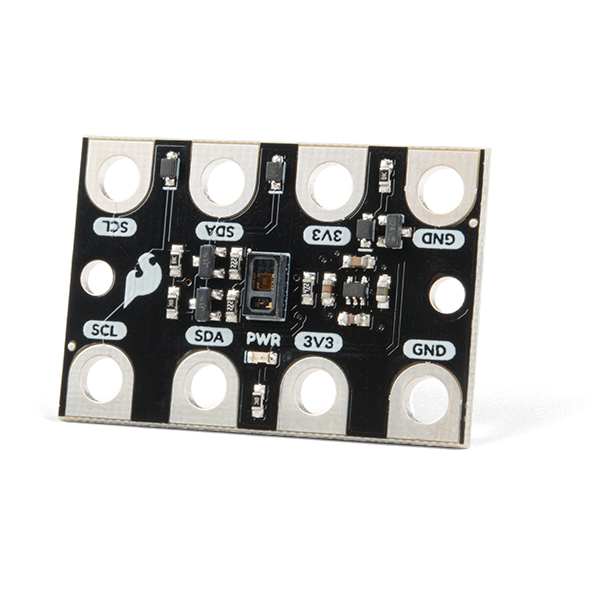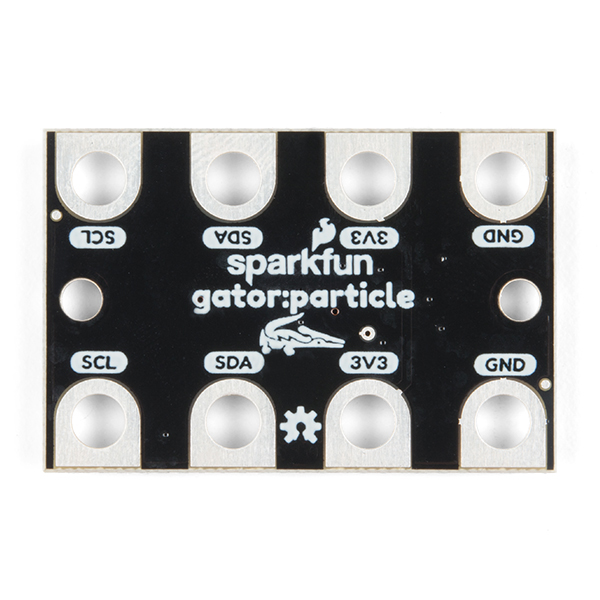SparkFun gator:particle - micro:bit Accessory Board
The SparkFun gator:particle micro:bit Accessory Board incorporates the powerful MAX30102 sensor, enabling sensing of pulse oximetry (SpO2) & heart rate (HR) monitoring. As part of SparkFun's gator:bit series of alligator-clippable accessories, it can be easily interfaced with the micro:bit or other microcontrollers via the SparkFun gator:bit! The MAX30102 includes internal LEDs, photodetectors, optical elements, and low-noise electronics with ambient light rejection. The idea is to pulse the different LEDs, then detect what shines back. Based on the reflected signature, it's possible to detect different types of particles or materials (such as oxygenated blood).
The MAX30102 is a high-sensitivity pulse oximeter and heart-rate sensor that communicates over an I2C bus. The specified operating voltage for the MAX30102 is between 1.7V-2V. For use with the gator:bit (v2) and micro:bit, you should provide 3.3V through the 3V3 and GND pads to keep the logic levels consistent; the 3.3V input is then regulated to 1.8V for the MAX30102.
The micro:bit is a pocket-sized computer that lets you get creative with digital technology. Between the micro:bit and our shield-like bit boards you can do almost anything while coding, customizing and controlling your micro:bit from almost anywhere! You can use your micro:bit for all sorts of unique creations, from robots to musical instruments and more. At half the size of a credit card, this versatile board has vast potential!
- gator:bit Compatible
- MAX30102: HR and SpO2 sensor
- Operating Voltage: 1.8-2V
- Supply Current:
- Heart Rate and SpO2 Mode: 600-1200µA
- IR Only Mode: 600-1200µA
- Operating Temperature: -40°-85°C
- (ΣΔ) ADC
- Resolution: 15-18-bits (programmable)
- Sampling Rate: 50-3200sps (programmable)
- IR LED
- LED Wavelength: 870-900nm (avg. 880nm)
- Forward Voltage: 1.4V
- Radiant Power: 6.5mW
- LED Driver Current: 0-50 mA (programmable)
- Red LED
- LED Wavelength: 650-670nm (avg. 660 nm)
- Forward Voltage: 2.1V
- Radiant Power: 9.8mW
- LED Driver Current: 0-50 mA (programmable)
- Photodetector
- Spectral Range of Sensitivity: 600-900nm
- Radiant Sensitive Area: 1.36mm2
- I2C Address
- 0xAE - Write Address
- 0xAF - Read Address
SparkFun gator:particle - micro:bit Accessory Board Product Help and Resources
SparkFun gator:particle Hookup Guide
June 13, 2019
The gator:particle is an I2C heart-rate monitor and pulse oximeter that can be used as a particle sensor. This tutorial will get you started using the gator:particle with the micro:bit platform.
SparkFun gator:bit v2 Hookup Guide
January 31, 2019
The gator:bit v2 is a breakout board for the BBC micro:bit. The gator:bit exposes almost every pin on the micro:bit to clippable pad with circuit protection. It also has as built-in addressable LEDs and a built-in buzzer.
Getting Started with the micro:bit
September 2, 2021
The BBC micro:bit is a compact, powerful programming tool that requires no software installation. Read on to learn how to use it YOUR way!
Core Skill: Programming
If a board needs code or communicates somehow, you're going to need to know how to program or interface with it. The programming skill is all about communication and code.
Skill Level: Rookie - You will need a better fundamental understand of what code is, and how it works. You will be using beginner-level software and development tools like Arduino. You will be dealing directly with code, but numerous examples and libraries are available. Sensors or shields will communicate with serial or TTL.
See all skill levels
Core Skill: Electrical Prototyping
If it requires power, you need to know how much, what all the pins do, and how to hook it up. You may need to reference datasheets, schematics, and know the ins and outs of electronics.
Skill Level: Rookie - You may be required to know a bit more about the component, such as orientation, or how to hook it up, in addition to power requirements. You will need to understand polarized components.
See all skill levels
Comments
Looking for answers to technical questions?
We welcome your comments and suggestions below. However, if you are looking for solutions to technical questions please see our Technical Assistance page.
Customer Reviews
No reviews yet.




